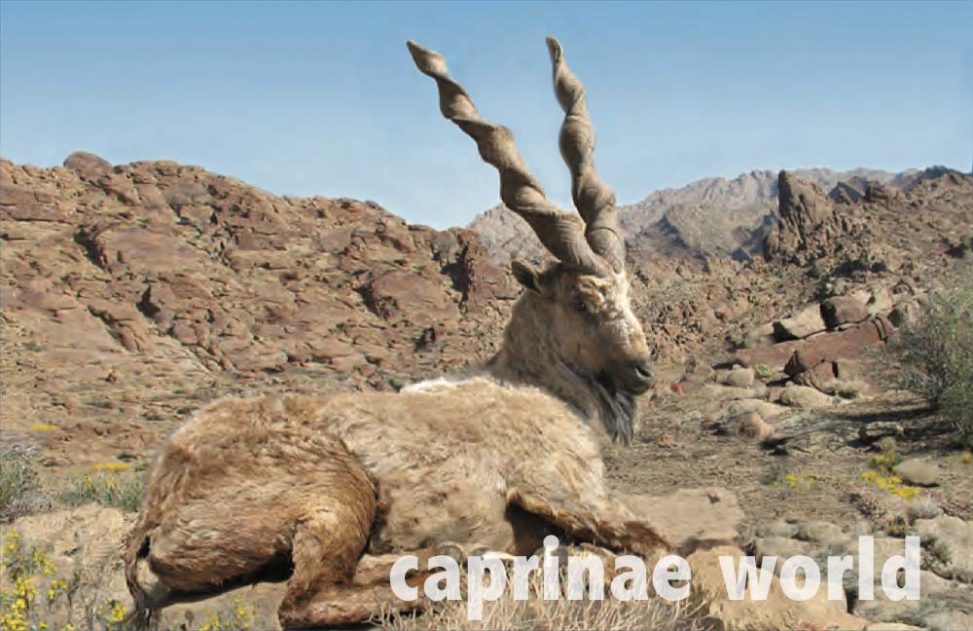As the name suggests: the distinctive feature of this subspecies is its straight horns. There are two phenotypes: Kabul Markhor and Suleiman Markhor. Both forms are rather small.
At one point both forms were considered distinct subspecies of the Markhor: Kabul Markhor (C. f. megaceros) and Suleiman Markhor (C. f. jerdoni). The two forms have been lumped to build Capra falconeri megaceros. Jerdoni is no more. The subspecific status of Jerdoni was given on the basis of tightly spiraling horns. Paradoxically, such horns appear to be in the minority in most of its range. [1] Therefore most authorities do not consider it a valid subspecies anymore. Within „caprinae world“ we still regard it as a distinct phenotype.
Names
English: Straight-horned Markhor – including Kabul Markhor and Suleiman (Sulaiman) Markhor [2]
German: We recommend „Geradhorn-Markhor“, following corresponding names in ornithology: Straight-billed Hermit (Phaethornis bourcieri) – Geradschnabeleremit; Straight-billed Reedhaunter (Limnornis rectirostris) – Geradschnabel-Riedschlüpfer; Straight-billed Woodcreeper (Xiphorhynchus picus) – Geradschnabel-Baumsteiger.
including: Kabul-Schraubenziege, Suleiman-Schraubenziege
French: Markhor de Kabul [2], Markhor du Kabul [1], Markhor du Suleiman [1], Markhor de Suleiman [2]
Spanish: Marjor de Kabul [2], Markor de Kabul, Markhor de Suleiman [1], Marjor de Suleimán [2]
Baluchi (a Northwestern Iranian language spoken primarily in the Balochistan region divided between Pakistan, Iran, and Afghanistan): Pachin, Sarah. [1,2]
Brahui (Dravidian language native to the Balochistan Province of Pakistan): Matt, Rezkuh [1]
Ladakhi (a Tibetic language spoken in the Ladakh union territory of India): Raphoche [1]
Pashto (one of the two official languages of Afghanistan; it is also the second-largest regional language of Pakistan): Maar Khur [1], „Markhor“ for the Suleiman Markhor [2]
Tibetan: Rira [1]
Taxonomic remarks / other scientific names and synonyms
Capra jerdoni, Hume 1874:240; Proc. Asiat. Soc. Bengal; Kinloch 1876: 15, Large Game Shooting, pt. II; Ward 1896:239, Records of Big Game. [2]
Capra falconeri jerdoni, Lydekker 1898:294, Wild Oxen, Sheep, and Goats; 1907:130, Game Animals of India, etc.; 1913:18, Cat. Hume Bequest Brit. Mus.; Ward 1910:367, Records of Big Game, ed. 6. Type locality: Suleman Range, Trans-Indus district of Punjab [2]
Capra megaceros, Hutton 1842:535, Calcutta Journ. Nat. Hist. vol. ii, pi. XX; 1846:161, Journ. Asiat. Soc. Bengal, vol. xv. Ward 1896:236, Records of Big Game. Type locality: Northern Afghanistan [2]
Diploid chromosome number: 2n = 58 [2]
Distribution
by country/state: Afghanistan and Pakistan
Straight-horned Markhor have a highly discontinuous distribution. Schaller (1977) believes that this is partly due to the erratic location of cliffs and isolated massifs and partly to indiscrimate hunting which has brought the subspecies to the verge of extinction. [10]
In Afghanistan, at least until 1978, this subspecies survived in the Kabul Gorge (Kabul Province) and the Kohe Safi area of Parwan Province, and possibly in some isolated pockets of Paktia Province. Intensive hunting pressure had forced it into the most inaccessible regions of its once wider range (Petocz et al. 1977, Valdez, 2008). No recent information is available on whether or not the subspecies is still extant in Afghanistan. [6]
The Kabul Markhor once ranged in a westerly arc from the Indus into Afghanistan to the vicinity of Kabul, and southward mainly in Pakistan as far as the Gumal River, which was generally considered its southern boundary (Burard, 1925). [10]
In Pakistan, the most comprehensive study of the distribution and status of the Straight-horned Markhor was published by Schaller and Khan (1975). The study showed a huge past range for this subspecies, but the actual range in Pakistan at that time consisted only of small isolated areas in Baluchistan Province, a small area in the former Northwest Frontier Province (NWFP), and one unconfirmed occurrence in Dera Ghazi Khan District (Punjab Province). Virk (1991) summarized the information for Baluchistan Province, and confirmed the subspecies’ presence in the area of the Koh-i-Sulaiman (Zhob District) and the Takatu hills (Quetta District), both according to Ahmad (1989). The presence of Straight-horned Markhor in the Torghar hills of the Toba Kakar range (Zhob District) has been repeatedly confirmed and it is possible that currently this area holds the only population consisting of more than 100 individuals of this subspecies (Tareen 1990, Frisina and Tareen 2009, Arshad and Khan 2009). Qadir Shah et al. (2010) and Mazhar Liaqat (2013) confirmed the presence of Straight-horned Markhor in the Ziarat Mountains in Ziarat District of Baluchistan Province. The NWFP Forest Department (NWFP 1987, 1992) considered that the areas of Mardan and Sheikh Buddin were still inhabited by the subspecies. There is no recent information about the Safed Koh range (Kurram and Khyber Districts) where, according to Schaller and Khan (1975) probably at least 100 animals lived on the Pakistan side of the border with Afghanistan in the early 1970s. [6]
The greatest concentration of the Suleiman Markhor can be found within the Qilla Saifullah district – north of Muslim Bagh, west of the towns of Zhob and Qilla Saifullah – in the Toba Kakar Mountain Ranges with the Torghar Hills as its most northerly extension (Schaller 1977; Roberts 1997; Bellon 2008). [2]
Habitat
At least in the south of the Suleiman Markhor’s range – the Zarghun- , Koh-e-Murdar- and Koh-i-Takatu Mountains – the animals occur in alpine dry steppe and steppe forest. [2]
The Torghar Hills (Black Hills) are a chain of rugged sandstone ridges, approximately 90 km long and 20 to 25 km wide, bounded on the North by the Kundar River Valley and on the south by the Khaisor Valley. The altidude varies between 2.500 and 3.300 m (Bellon 2008). [2]
Description
general appearance: Kabul and Suleiman Markhor represent a smaller phenotype, weighing around 70 kg with a shoulder height of 95 cm. [2] Despite the same measurements for both phenotypes Damm and Franco (2014) write that the Suleiman Markhor represents the smallest Markhor.
Pelage: The pelage of Kabul Markhor has somewhat shorter hairs than the northern types. [2] The Suleiman Markhor is said to be adapted to the hot, dry desert climate. [2]
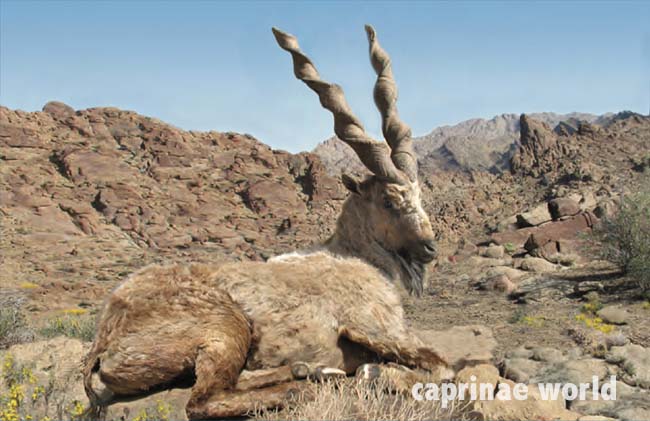
pelage colour of both phenotypes is said to be similar: rather light and creamy coloured to light brownish intermingled with grey [2]. Compared with Markhors from the northern subspecies the Suleiman Markhor is said to be more greyish. [10]
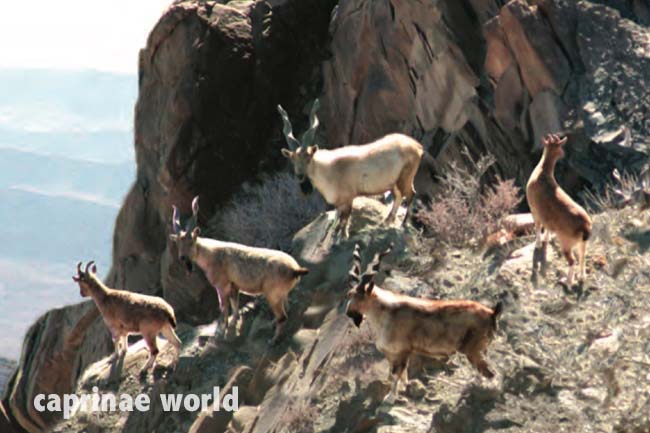
face: dark; contrasting with the light body [2]
neck ruff: in the Suleiman Markhor shorter than in any other Markhor; in the Kabul Markhor it is longer [2]
beard: black and curves forward [2]
dorsal stripe: faint; on the posterior half of the back [2]
underparts: whitish; separated from the flanks through a dark stripe [2]
tail: blackish [2]
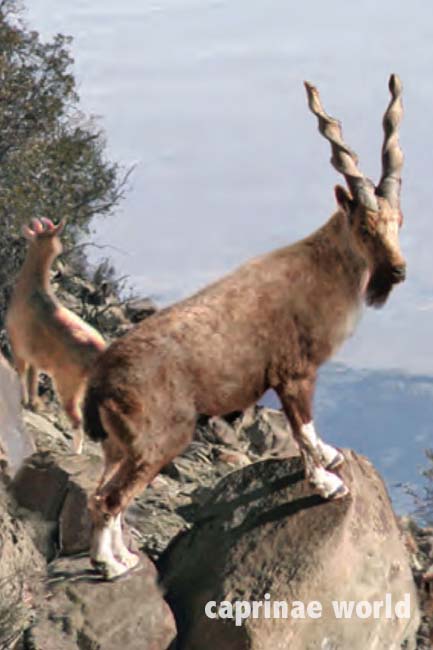
legs: lower parts and inner sides of the legs are white; hindquarters and lower shoulders, as well as the upper parts of the fore and hind legs are dark; also darkish stripe on the frontal part below the „knee“, reaching almost to the fetlocks [2]
females: have a grey face and fawn-coloured coat except for their whitish chins, undersides, and lower legs; a dark line runs down the back and another from chin to chest; and the beard is short and wispy. [10]
More differences between the phenotypes: The Kabul Markhor in the Safed Koh and in Afghanistan are larger and have longer ruffs than most Sulaiman Markhor, except for those on Takht-i-Sulaiman (Stockley, 1936). Stockley (1928) also felt that the southern animals are „much squarer in build.“ In spite of such differences Schaller (1977) suggests that the straight-horned types be combined into one subspecies, C. f. megaceros. [10]
Horns
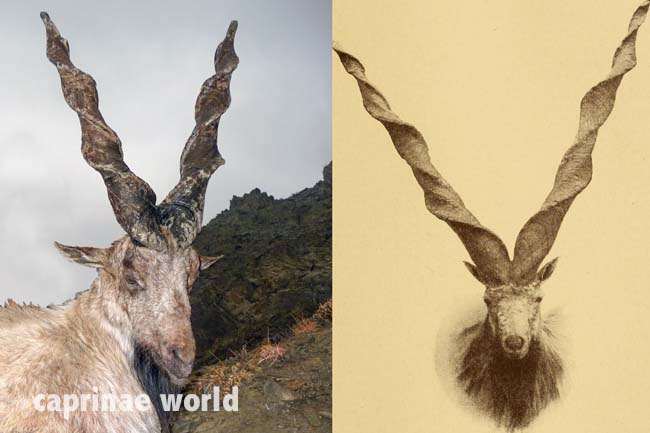
Damm and Franco (2014) describe the horns of the Kabul type as generally forming „an almost straight cone, on the surface of which the front and hind keels are wound in a sharp open spiral of two, three, and occasionally four complete turns.“ Accompanying photos of Kabul Markhor sculls from the Field Museum of Natural History, Chicago, show horns with three turns.
Horns of Suleiman Markhor at the southern extreme of the Markhor distribution range usually show a compact multi-spiral. The axis of the horns is typically a perfect straight cone on the surface of which the front and the hind keels are wound in tightly twisted spirals. The two straight horns approximate an inverted triangle with the tip situated more or less at the nose tip of the animal. Occasionally more open, but heavily twisted forms with a barely perceivable degree of flare are found. [2]
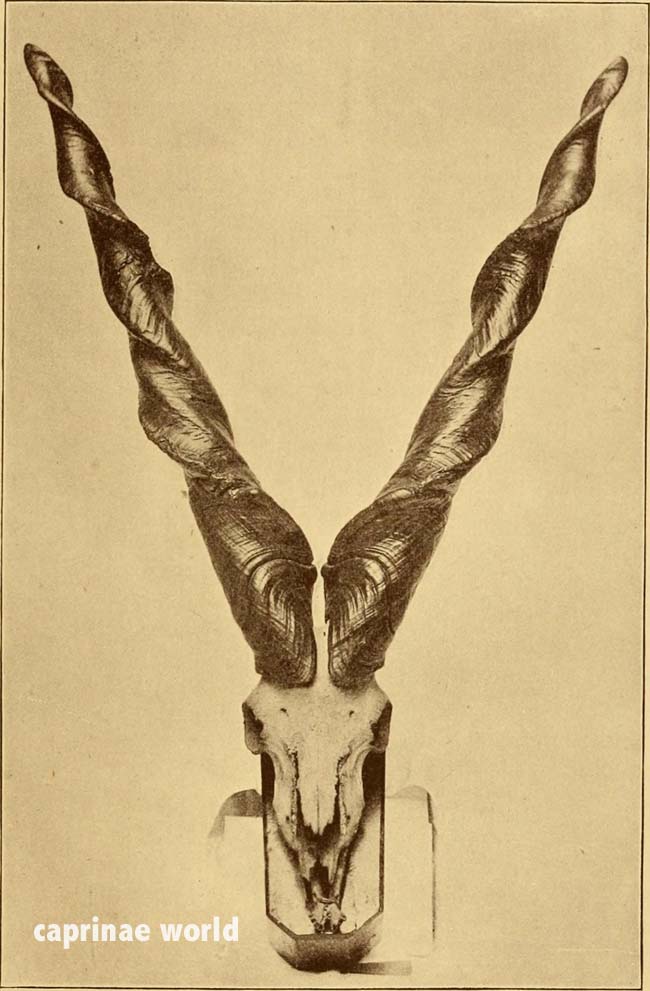
Damm and Franco (2014) conclude that the Kabul Markhor has a horn shape intermediate between the more northern forms and the Suleiman Markhor. [2]
However as pointed out before horn types are by no means constant. Lydekker (1913) recorded specimens of Kabul Markhor from Quetta far within the supposed range of the Suleiman Markhor, and he wrote an article, illustrated with a painting (1902), about a Kabul Markhor from Chitral – which lies wholly within the range of the Kashmir Markhor. [10]
In spite of these bewildering statements Schaller (1977) writes that a quantitative geographical division between Straight-horned and Flare-horned Markhor can be made: Only 2 (3 per cent) of 65 Kabul and Sulaiman Markhor examined in Pakistan had slightly flaring horns: [10]
„For the Straight-horned Markhor, horns of two types – open and tightly spiralled – may be found in the same population with, however, differing frequencies. Of 25 Kabul Markhor examined from the Sakra, Safed Koh, and Marwat Ranges, 100 per cent had open spirals; of 10 Sulaiman Markhor from the Gadabar Ghar 100 per cent had open spirals, of 9 from the Toba-Kakar 89 per cent had open spirals, and of 20 from around Quetta 65 per cent had open spirals. The Sulaiman Markhor was first given subspecific status on the basis of tight-spiralling horns, but such horns are in a minority at least in the populations from which my samples were drawn. Horn circumference is similar in both forms, averaging 23 cm (20-26 cm) in 15 trophies 5 years old and older. I am unable to distinguish an open-spiralled Sulaiman horn from a Kabul one. Subspecific distinctions here seem unwarranted on the basis of horn shape.“ [10]
Kabul horns longer than those of the Suleiman? The often imprecise harvest locations make interpretations of existing Kabul Markhor recordings difficult. So whether the horns of the Kabul Markhor are on average longer than those of the Suleiman type, cannot be answered with finality. The record Kabul Markhor specimen from Afghanistan (without precise location) registered in Rowland Ward measures 110,2 cm in length over the curve. The horn lenghts of some specimens taken in the early 20th century were measured straight up on the front of the horn without following the spiral. One such Markhor head from Afghanistan had a horn length of 100 cm. [2]
The small Straight-horned Markhor – victim of its habitat: Growth rates are similar in all Markhor populations until the animals are about 4 years old. After that the average annual increments of the Straight-horned Markhor become smaller than those of the flare-horned ones. Since relative horn length in the two types is similar, the data suggest that the Straight-horned Markhor grow little in body or in horn length after they become fully adult and that the general size difference between the two subspecies can be related not to an initial growth spurt in subadults but to differential growth rates among adults. The fact that Flare-horned Markhor usually live in a more favourable environment than do straight-horned ones is no doubt significant. [10]
Status
In Afghanistan, few animals survived even in the late 1990s, perhaps 50-80 in the Kohe Safi region, with a few in other isolated pockets (Valdez 2008). No recent information is available on the population numbers of Straight-horned Markhor in Afghanistan. The subspecies may be extirpated in the country, but potentially Markhor from Pakistan (e.g., Torghar hills) may cross into Afghanistan. [6]
In Pakistan, population numbers for Straight-horned Markhor are well documented for the Torghar Hills (Baluchistan). Roberts (1969) believed that the main concentration of the Straight-horned Markhor was in the Toba Kakar and Torghar hills and numbers could have been less than 500. In 1984, Tareen estimated that fewer than 200 Markhor remained in the Torghar Hills (Mitchell 1989, quoted in USFWS 2012). The estimate by Frisina (pers. comm. 2014) of 1,684 for 1999 represents a substantial increase compared to Johnson (1997) who estimated there were 695 Sulaiman Markhor in the Torghar Hills in 1994. Rosser et al. (2005) summarized results from surveys that suggested Markhor in the Torghar Hills had increased to over 1,600 by the year 2000. Arshad and Khan (2009) presented an estimate of 3,158 Markhor in Torghar in 2008. M. Frisina (pers. comm. 2014) considered this estimate possibly biased, and based on a new, conservative analysis of these data, suggested revising this estimate to 1,729. The most recent population estimate of 2,829 in 2011 is from M. Frisina (pers. comm. 2014). [6]
There is no recent estimate for Straight-horned Markhor in other areas in Pakistan, but we assume there to be about 200 C. f. megaceros in other areas of Baluchistan and Khyber-Pakhtunkhwa. Schaller and Khan (1975) estimated 150 Straight-horned Markhor in the Takatu hills in 1971, but later Ahmad (1989) reported that only 50 still existed in these hills, and only 100 in the area of Koh-i-Sulaiman. In the Ziarat Mountains in Balochistan, Qadir Shah et al. (2010) recorded nine and Mazhar Liaqat (2013) counted 32 Straight-horned Markhor. The NWFP Forest Department (NWFP 1992) gave a total of only 24 animals for the whole province: 12 for the Mardan area, and 12 for the Sheikh Buddin National Park. [6]
Although an accurate estimate of the total number of this subspecies is not possible, it can be assumed that with the population in the Torghar Hills estimated at 2.829 in 2011 (M. Frisina pers. comm. 2014) the total number might be slightly above 3.000 animals. In the 1990s this total was assumed to be around 870 (Ahmad 1989, NWFP 1992, Johnson 1997 quoted in Frisina and Tareeen 2009, Valdez 2008). Schaller and Khan (1975) estimated that more than 2,000 individuals remained throughout the entire range of Straight-horned Markhor in Pakistan. Roberts (1969) estimated that the total population of the former subspecies C. f. jerdoni, restricted mainly to the Province of Baluchistan, may have exceeded 1,000 animals, but that it was severely threatened because it survived in discontinuous and isolated pockets. For this same area, Schaller and Khan (1975) estimated fewer than 1.000 animals. Thus, over the past 20 years, numbers have recovered substantially, but this is known only for one area, the Torghar Hills. [6]
Threats
Valdez (2008) reported that in Afghanistan excessive hunting by local people and forage competition with livestock were pushing Markhor to the periphery of its range. Such severe pressure was leading the population to a slow demise, and its status is unlikely to have improved since. [6]
In Pakistan, the most important threat to subpopulations outside the Torghar Conservancy is illegal hunting. Other threats include competition with livestock, risk of disease transmission from livestock (Woodford et al. 2004), habitat degradation, and habitat loss (Sheikh and Molur 2004). According to Hess et al. (1997), significant habitat loss was caused by logging in the Sulaiman Range, which they considered the most important area of straight-horned Markhor’s distribution. No recent data on the Markhor in the Sulaiman range are available and recent satellite images from 2011 and 2013 (Google Earth, accessed 2014) suggest that habitat conditions in the Sulaiman range are still largely suitable for Markhor. [6]
Another threat for all Markhor subspecies may be posed by the spillover of contagious diseases from domestic goats and other livestock sharing Markhor habitat. Contagious Caprine Pleuropneumonia (CCPP), a contagious, lethal disease to caprids, perhaps overlooked for long time in the north of Pakistan, was recently confirmed to be present in domestic goats in Gilgit-Baltistan and south-western Tajikistan (Peyraud et al. 2014). Mycoplasma capricolum subsp. capricolum, an infectious bacterium hosted by domestic goats, killed at least 64 Markhor in fall 2010 in one area in Tajikistan (Ostrowski et al. 2011). In India diseases such as foot and mouth disease are reportedly common in livestock and can infect Markhor (Ranjitsinh et al. 2007). [6]
Hybridization with domestic goats may be a potential threat for all subspecies as goats commonly graze in Markhor habitats. Hammer et al. (2008) found introgressive hybridization with domestic goat among 35.7% of Markhor from three zoos, and speculated that in some cases introgressed wild living ancestral C. falconeri herds may have been the source populations of captive Markhor. [6]
Hunting
At present Straight-horned Markhor can only be hunted in Pakistan – and only the Suleiman type. Hunting in Afghanistan is closed by presidential order. Kabul Markhor in Pakistan cannot be hunted. [2]
Damm and Franco (2014) believe the Torghar Conservation Project (TCP) in the Torghar Hills to be „arguably the most successful community-based Caprinae conservation project in Pakistan and possibly worldwide“. TCP was established in 1986 with the involvement of local tribes. US wildlife biologists provided technical input that was needed to achieve conservation goals through a sustainable-use model that would also bring measurable benefits to the local population. Using revenue from the sale of a small number of trophy hunts, local people were hired as wildlife guards, with the condition that they agreed to stop poaching. There were probably no more than 100 Suleiman Markhor left when the program started in 1985 (FAO 2006). in 2009 the population was estimated at around 3.100 Suleiman Markhor.
Literature cited
[0] Bellon, Luc, 2008: A Treasure in My Backyard: Suleiman Markhor. SUSG-C Asia, Quetta.
[1] Castelló, José R., 2016: Bovids of the World – Antelopes, Gazelles, Cattle, Goats, Sheep, and Relatives. Princeton University Press
[2] Damm, Gerhard R. and Franco, Nicolás, 2014: The CIC Caprinae Atlas of the World – CIC International Council for Game and Wildlife Conservation, Budakeszi, Hungary in cooperation with Rowland Ward Publications RSA (Pty) Ltd., Johannesburg, South Africa
[6] Michel, S. & Rosen Michel, T. 2015. Capra falconeri (errata version published in 2016). The IUCN Red List of Threatened Species 2015: e.T3787A97218336. https://dx.doi.org/10.2305/IUCN.UK.2015-4.RLTS.T3787A82028427.en. Downloaded on 06 May 2020.
Lydekker, Richard, 1907: The Game Animals of India, Burma, Malaya, and Tibet: Being a New and Revised Edition of ‚The Great and Small Game of India, Burma, and Tibet‘. Harvard University, R. Ward, limited
[10] Schaller, George B., 1977: Mountain Monarchs – wild sheep and goats of the Himalaya. The University of Chicago Press
[11] Shackleton, David M. (editor) and the IUCN/SSC Caprinae Specialist Group, 1997: Wild Sheep and Goats and their Relatives. Status Survey and Conservation Action Plan for Caprinae. IUCN, Gland, Switzerland and Cambridge, UK. 390 + vii pp.

